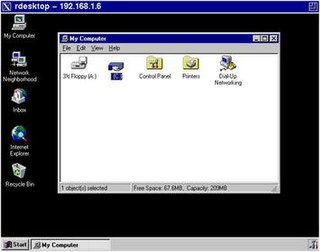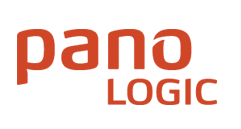
Virtual Network Computing (VNC) is a graphical desktop-sharing system that uses the Remote Frame Buffer protocol (RFB) to remotely control another computer. It transmits the keyboard and mouse input from one computer to another, relaying the graphical-screen updates, over a network.
Remote Desktop Protocol (RDP) is a proprietary protocol developed by Microsoft Corporation which provides a user with a graphical interface to connect to another computer over a network connection. The user employs RDP client software for this purpose, while the other computer must run RDP server software.
A remote access service (RAS) is any combination of hardware and software to enable the remote access tools or information that typically reside on a network of IT devices.
NX technology, commonly known as NX or NoMachine, is a remote access and remote control computer software, allowing remote desktop access and maintenance of computers. It is developed by the Luxembourg-based company NoMachine S.à r.l.. NoMachine is proprietary software and is free-of-charge for non-commercial use.
Remote administration refers to any method of controlling a computer or other Internet-connected device, such as a smartphone, from a remote location. There are many commercially available and free-to-use software that make remote administration easy to set up and use. Remote administration is often used when it's difficult or impractical to be physically near a system in order to use it or troubleshoot it. Many server administrators also use remote administration to control the servers around the world at remote locations. It is also used by companies and corporations to improve overall productivity as well as promote remote work. It may also refer to both legal and illegal remote administration.

Microsoft NetMeeting is a discontinued VoIP and multi-point videoconferencing program offered by Microsoft. NetMeeting allows multiple clients to host and join a call that includes video and audio, text chat, application and desktop sharing, and file sharing. It was originally bundled with Internet Explorer 3 and then with Windows versions from Windows 95 to Windows Server 2003.

rdesktop is an implementation of a client software for Microsoft's proprietary Remote Desktop Protocol (RDP). Rdesktop is free and open-source software, subject to the requirements of the GNU General Public License (GPL-3.0-or-later), and is available for Linux and BSD as well as for Microsoft Windows.

Quick Assist is a Microsoft Windows feature that allows a user to view or control a remote Windows computer over a network or the Internet to resolve issues without directly touching the unit. It is based on the Remote Desktop Protocol (RDP). It is complemented by Get Help, a feature introduced in Windows 10 that enables the user to contact Microsoft directly but does not allow for remote desktoping or screen sharing.
Desktop virtualization is a software technology that separates the desktop environment and associated application software from the physical client device that is used to access it.
Microsoft Application Virtualization is an application virtualization and application streaming solution from Microsoft. It was originally developed by Softricity, a company based in Boston, Massachusetts, acquired by Microsoft on July 17, 2006. App-V represents Microsoft's entry to the application virtualization market, alongside their other virtualization technologies such as Hyper-V, Microsoft User Environment Virtualization (UE-V), Remote Desktop Services, and System Center Virtual Machine Manager.
In computing, the term remote desktop refers to a software- or operating system feature that allows a personal computer's desktop environment to be run remotely from one system, while being displayed on a separate client device. Remote desktop applications have varying features. Some allow attaching to an existing user's session and "remote controlling", either displaying the remote control session or blanking the screen. Taking over a desktop remotely is a form of remote administration.
Remote Desktop Services (RDS), known as Terminal Services in Windows Server 2008 and earlier, is one of the components of Microsoft Windows that allow a user to initiate and control an interactive session on a remote computer or virtual machine over a network connection. RDS was first released in 1998 as Terminal Server in Windows NT 4.0 Terminal Server Edition, a stand-alone edition of Windows NT 4.0 Server that allowed users to log in remotely. Starting with Windows 2000, it was integrated under the name of Terminal Services as an optional component in the server editions of the Windows NT family of operating systems, receiving updates and improvements with each version of Windows. Terminal Services were then renamed to Remote Desktop Services with Windows Server 2008 R2 in 2009.

Pano Logic was a manufacturer of devices which present virtual desktops to the end user with no local processing power. They describe this concept as "zero client". This is perceived as offering benefits in end-user support and in power provision to desks. OEM versions have been included in displays from some vendors, allowing a single unit to be deployed. The company failed in October 2012. In March 2013, Propalms announced they had acquired the rights to support Panologic customers, and will "help transition the customer base to a new platform".

GraphOn GO-Global is a multi-user remote access application for Windows. GO-Global is a product of GraphOn Corporation.
Microsoft RemoteFX is a Microsoft brand name that covers a set of technologies that enhance visual experience of the Microsoft-developed remote display protocol Remote Desktop Protocol (RDP). RemoteFX was first introduced in Windows Server 2008 R2 SP1 and is based on intellectual property that Microsoft acquired and continued to develop since acquiring Calista Technologies. It is a part of the overall Remote Desktop Services workload.
VideoOverIP is a remote desktop protocol developed by Texas-based, desktop virtualization and cloud computing company VDIworks.

Chrome Remote Desktop is a remote desktop software tool, developed by Google, that allows a user to remotely control another computer's desktop through a proprietary protocol also developed by Google, internally called Chromoting. The protocol transmits the keyboard and mouse events from the client to the server, relaying the graphical screen updates back in the other direction over a computer network. This feature, therefore, consists of a server component for the host computer, and a client component on the computer accessing the remote server. Chrome Remote Desktop uses a unique protocol, as opposed to using the common Remote Desktop Protocol.

xrdp is a free and open-source implementation of Microsoft RDP server that enables operating systems other than Microsoft Windows to provide a fully functional RDP-compatible remote desktop experience. It works by bridging graphics from the X Window System to the client and relaying controls from the client back to X Window Server.
Azure Virtual Desktop (AVD), formerly known as Windows Virtual Desktop (WVD), is a Microsoft Azure-based system for virtualizing its Windows operating systems, providing virtualized desktops and applications securely in the cloud using the Remote Desktop Protocol. It is aimed at enterprise customers rather than at individual users.





